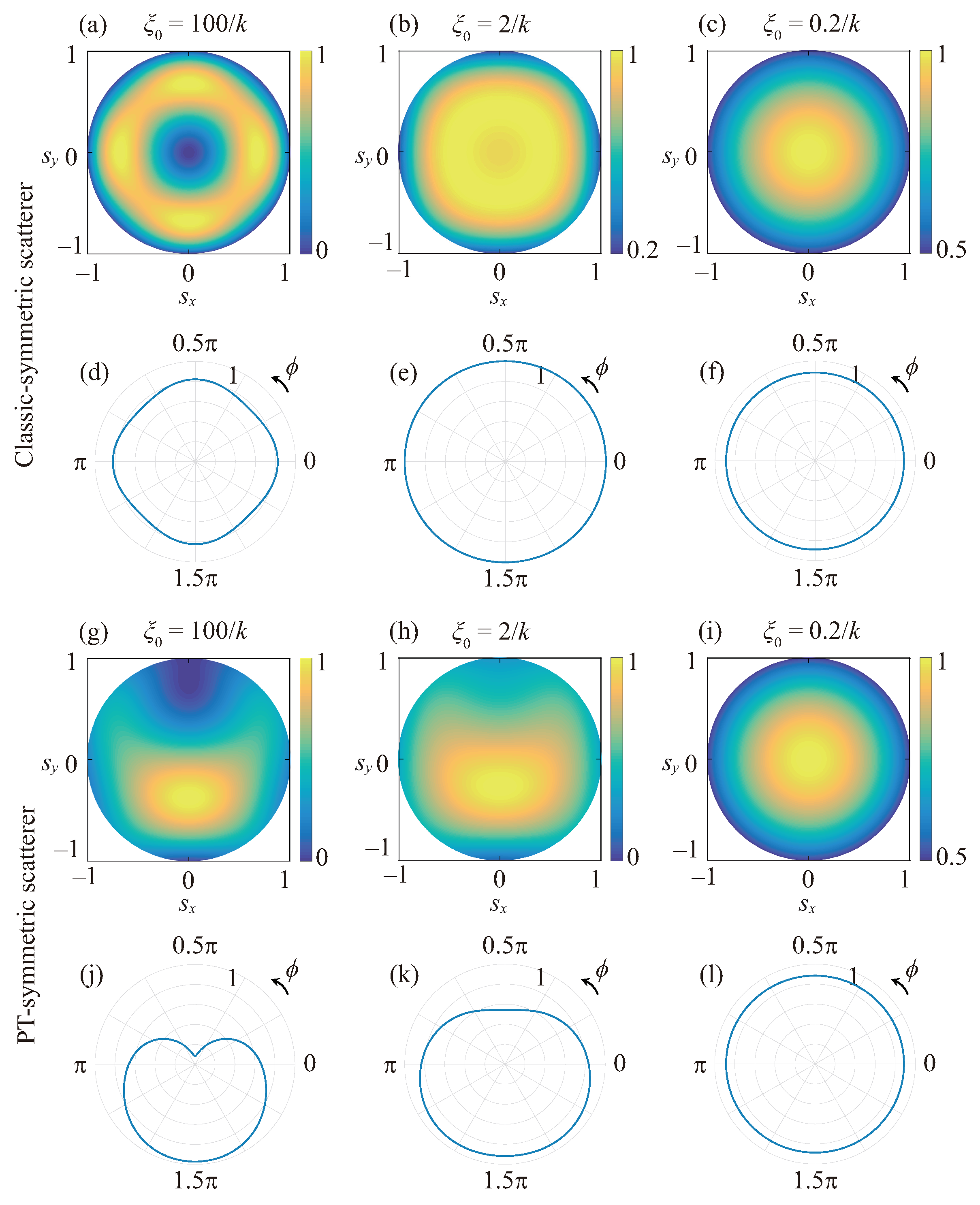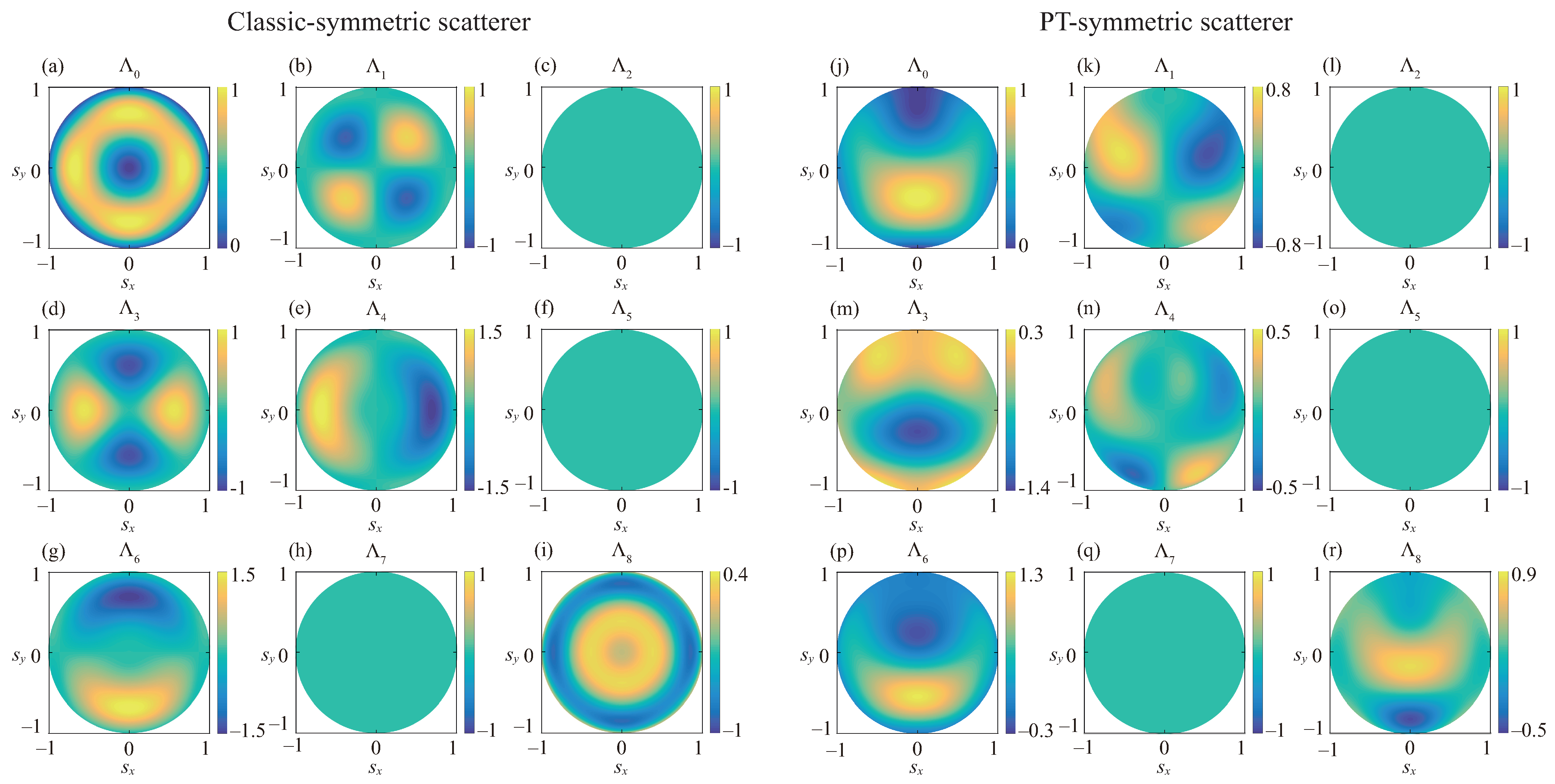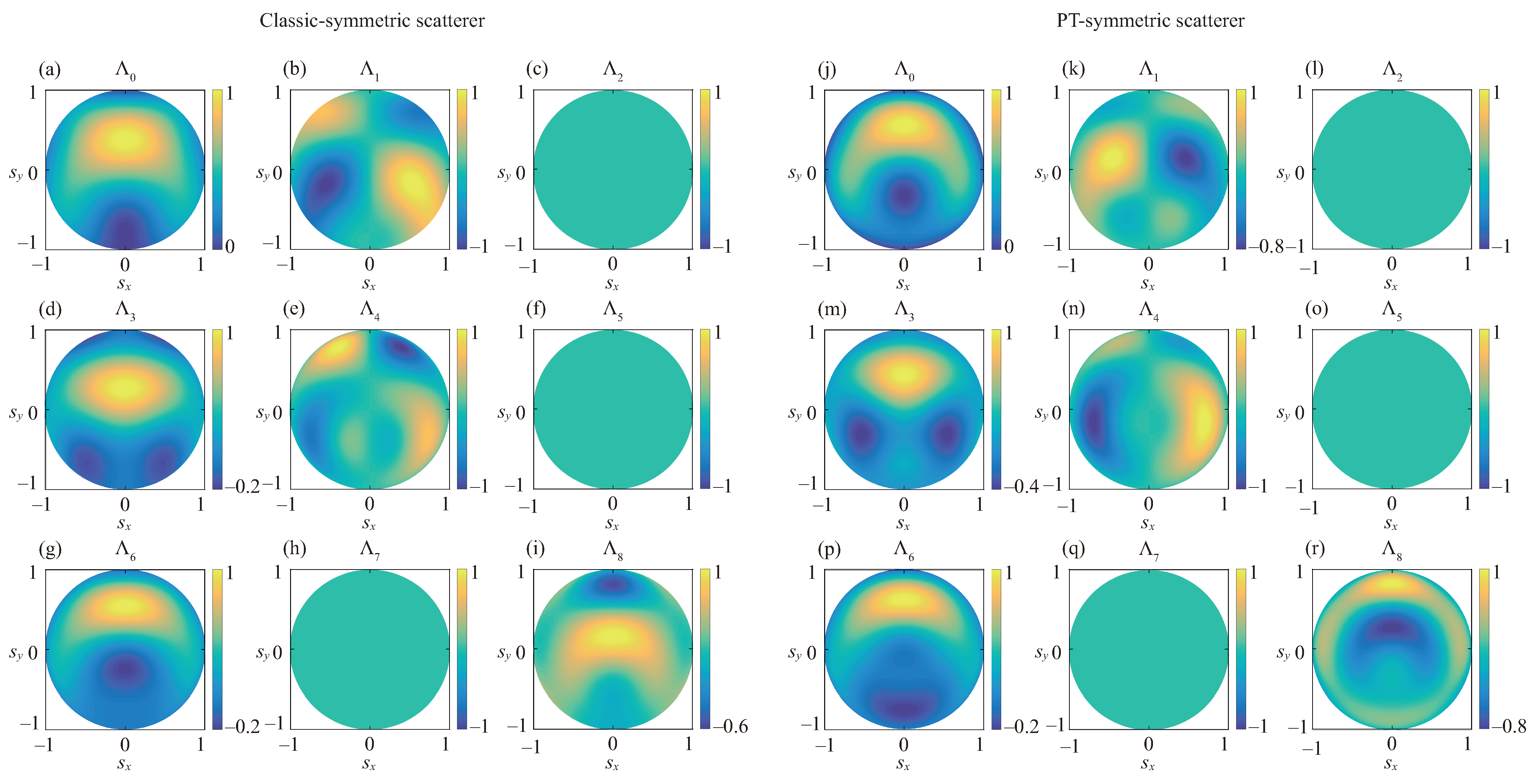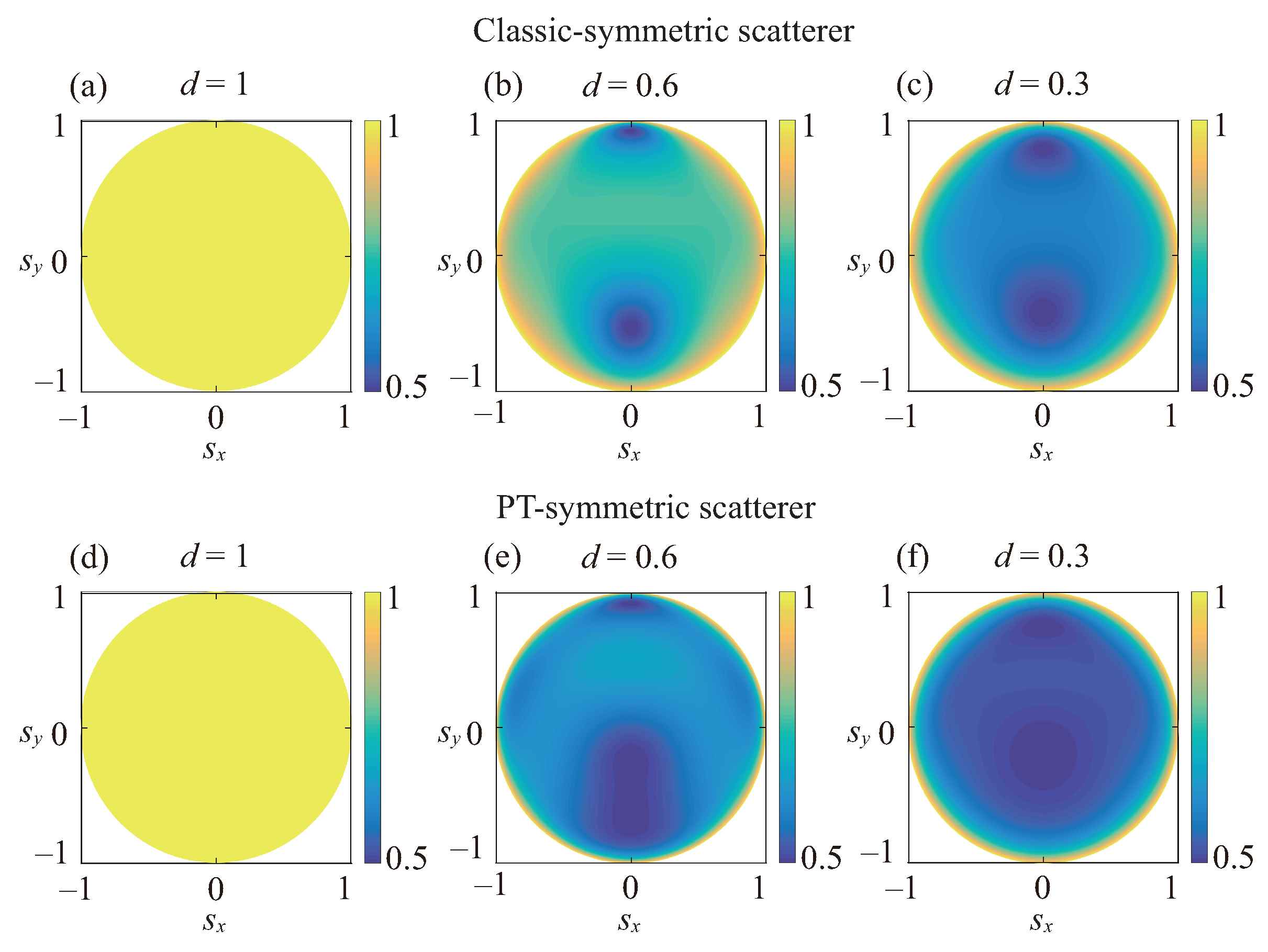Scattering of Partially Coherent Vector Beams by a Deterministic Medium Having Parity-Time Symmetry
Abstract
:1. Introduction
2. Method
2.1. Scattering Theory for Partially Coherent Vector Beam
2.2. PT Symmetry in Scattering Medium
2.3. PT Symmetry in Partially Coherent Vector Beam
3. Results
3.1. Four-Point Scatterer
3.2. Partially Coherent Vector Beam with Spatially Nonuniform Radial Polarization
3.2.1. Degree of Coherence with Classical Symmetry
3.2.2. Degree of Coherence with PT Symmetry
4. Discussion
5. Conclusions
Author Contributions
Funding
Institutional Review Board Statement
Informed Consent Statement
Data Availability Statement
Conflicts of Interest
References
- Brosseau, C. Fundamentals of Polarized Light: A Statistical Approach; Wiley: New York, NY, USA, 1998. [Google Scholar]
- Gori, F. Matrix treatment for partially polarized, partially coherent beams. Opt. Lett. 1998, 23, 241–243. [Google Scholar] [CrossRef] [PubMed]
- Wolf, E. Unified theory of coherence and polarization of random electromagnetic beams. Phys. Lett. A 2003, 312, 263–267. [Google Scholar] [CrossRef]
- Tervo, J.; Setälä, T.; Friberg, A.T. Degree of coherence for electromagnetic fields. Opt. Express 2003, 11, 1137–1143. [Google Scholar] [CrossRef] [PubMed]
- Wolf, E. Introduction to the Theory of Coherence and Polarization of Light; Cambridge University Press: Cambridge, UK, 2007. [Google Scholar]
- Friberg, A.T.; Setälä, T. Electromagnetic theory of optical coherence. J. Opt. Soc. Am. A 2016, 33, 2431–2442. [Google Scholar] [CrossRef] [PubMed]
- Setälä, T.; Shevchenko, A.; Kaivola, M.; Friberg, A.T. Degree of polarization for optical near fields. Phys. Rev. E 2002, 66, 016615. [Google Scholar] [CrossRef] [Green Version]
- James, D.F. Change of polarization of light beams on propagation in free space. J. Opt. Soc. Am. A 1994, 11, 1641–1643. [Google Scholar] [CrossRef]
- Korotkova, O.; Wolf, E. Changes in the state of polarization of a random electromagnetic beam on propagation. Opt. Commun. 2005, 246, 35–43. [Google Scholar] [CrossRef]
- Vidal, I.; Fonseca, E.J.; Hickmann, J.M. Light polarization control during free-space propagation using coherence. Phys. Rev. A 2011, 84, 033836. [Google Scholar] [CrossRef]
- Gori, F.; Santarsiero, M.; Borghi, R.; Ramírez-Sánchez, V. Realizability condition for electromagnetic Schell-model sources. J. Opt. Soc. Am. A 2008, 25, 1016–1021. [Google Scholar] [CrossRef]
- Korotkova, O. Scintillation index of a stochastic electromagnetic beam propagating in random media. Opt. Commun. 2008, 281, 2342–2348. [Google Scholar] [CrossRef]
- Salem, M.; Wolf, E. Coherence-induced polarization changes in light beams. Opt. Lett. 2008, 33, 1180–1182. [Google Scholar] [CrossRef] [PubMed]
- Zhao, C.; Cai, Y.; Korotkova, O. Radiation force of scalar and electromagnetic twisted Gaussian Schell-model beams. Opt. Express 2009, 17, 21472–21487. [Google Scholar] [CrossRef] [PubMed]
- Tong, Z.; Cai, Y.; Korotkova, O. Ghost imaging with electromagnetic stochastic beams. Opt. Commun. 2010, 283, 3838–3845. [Google Scholar] [CrossRef]
- Sahin, S.; Tong, Z.; Korotkova, O. Sensing of semi-rough targets embedded in atmospheric turbulence by means of stochastic electromagnetic beams. Opt. Commun. 2010, 283, 4512–4518. [Google Scholar] [CrossRef]
- Zhu, S.; Cai, Y.; Korotkova, O. Propagation factor of a stochastic electromagnetic Gaussian Schell-model beam. Opt. Express 2010, 18, 12587–12598. [Google Scholar] [CrossRef]
- Dong, Y.; Cai, Y.; Zhao, C.; Yao, M. Statistics properties of a cylindrical vector partially coherent beam. Opt. Express 2011, 19, 5979–5992. [Google Scholar] [CrossRef]
- Ostrovsky, A.S.; Olvera-Santamaría, M.Á.; Romero-Soría, P.C. Effect of coherence and polarization on resolution of optical imaging system. Opt. Lett. 2011, 36, 1677–1679. [Google Scholar] [CrossRef]
- Dong, Y.; Wang, F.; Zhao, C.; Cai, Y. Effect of spatial coherence on propagation, tight focusing, and radiation forces of an azimuthally polarized beam. Phys. Rev. A 2012, 86, 013840. [Google Scholar] [CrossRef]
- Cai, Y.; Wang, F.; Zhao, C.; Zhu, S.; Wu, G.; Dong, Y. Partially coherent vector beams: From theory to experiment. Vectorial Opt. Fields Fundam. Appl. 2013, 7, 221–273. [Google Scholar]
- Chen, Y.; Wang, F.; Liu, L.; Zhao, C.; Cai, Y.; Korotkova, O. Generation and propagation of a partially coherent vector beam with special correlation functions. Phys. Rev. A 2014, 89, 013801. [Google Scholar] [CrossRef]
- Hyde IV, M.W.; Bose-Pillai, S.; Voelz, D.G.; Xiao, X. Generation of vector partially coherent optical sources using phase-only spatial light modulators. Phys. Rev. Appl. 2016, 6, 064030. [Google Scholar] [CrossRef] [Green Version]
- Yu, J.; Huang, Y.; Wang, F.; Liu, X.; Gbur, G.; Cai, Y. Scintillation properties of a partially coherent vector beam with vortex phase in turbulent atmosphere. Opt. Express 2019, 27, 26676–26688. [Google Scholar] [CrossRef]
- Mao, H.; Chen, Y.; Liang, C.; Chen, L.; Cai, Y.; Ponomarenko, S.A. Self-steering partially coherent vector beams. Opt. Express 2019, 27, 14353–14368. [Google Scholar] [CrossRef] [PubMed]
- Yu, J.; Zhu, X.; Lin, S.; Wang, F.; Gbur, G.; Cai, Y. Vector partially coherent beams with prescribed non-uniform correlation structure. Opt. Lett. 2020, 45, 3824–3827. [Google Scholar] [CrossRef]
- Zhu, X.; Yu, J.; Wang, F.; Chen, Y.; Cai, Y.; Korotkova, O. Synthesis of vector nonuniformly correlated light beams by a single digital mirror device. Opt. Lett. 2021, 46, 2996–2999. [Google Scholar] [CrossRef] [PubMed]
- Peng, D.; Huang, Z.; Liu, Y.; Chen, Y.; Wang, F.; Ponomarenko, S.A.; Cai, Y. Optical coherence encryption with structured random light. PhotoniX 2021, 2, 6. [Google Scholar] [CrossRef]
- Liu, Y.; Chen, Y.; Wang, F.; Cai, Y.; Liang, C.; Korotkova, O. Robust far-field imaging by spatial coherence engineering. Opto-Electron. Adv. 2021, 4, 210027. [Google Scholar] [CrossRef]
- Liu, Y.; Zhang, X.; Dong, Z.; Peng, D.; Chen, Y.; Wang, F.; Cai, Y. Robust Far-Field Optical Image Transmission with Structured Random Light Beams. Phys. Rev. Appl. 2022, 17, 024043. [Google Scholar] [CrossRef]
- Chen, Y.; Wang, F.; Cai, Y. Partially coherent light beam shaping via complex spatial coherence structure engineering. Adv. Phys. X 2022, 7, 2009742. [Google Scholar] [CrossRef]
- Born, M.; Wolf, E. Principles of Optics; Cambridge University Press: Cambridge, UK, 1999. [Google Scholar]
- Mandel, L.; Wolf, E. Optical Coherence and Quantum Optics; Cambridge University Press: Cambridge, UK, 1995. [Google Scholar]
- Zhao, D.; Wang, T. Direct and inverse problems in the theory of light scattering. Prog. Opt. 2012, 57, 261–308. [Google Scholar]
- Cabaret, D.; Rossano, S.; Brouder, C. Mie scattering of a partially coherent beam. Opt. Commun. 1998, 150, 239–250. [Google Scholar] [CrossRef]
- Greffet, J.J.; De La Cruz-Gutierrez, M.; Ignatovich, P.V.; Radunsky, A. Influence of spatial coherence on scattering by a particle. J. Opt. Soc. Am. A 2003, 20, 2315–2320. [Google Scholar] [CrossRef] [PubMed]
- Korotkova, O.; Wolf, E. Scattering matrix theory for stochastic scalar fields. Phys. Rev. E 2007, 75, 056609. [Google Scholar] [CrossRef] [PubMed]
- van Dijk, T.; Fischer, D.G.; Visser, T.D.; Wolf, E. Effects of spatial coherence on the angular distribution of radiant intensity generated by scattering on a sphere. Phys. Rev. Lett. 2010, 104, 173902. [Google Scholar] [CrossRef] [Green Version]
- Sukhov, S.; Haefner, D.; Bae, J.; Ma, D.; Carter, D.R.; Dogariu, A. Effect of spatial coherence on scattering from optically inhomogeneous media. J. Opt. Soc. Am. A 2012, 29, 85–88. [Google Scholar] [CrossRef]
- Liu, Y.; Zhang, X. Coherent effect in superscattering. J. Opt. Soc. Am. A 2016, 33, 2071–2075. [Google Scholar] [CrossRef]
- Schouten, H.F.; Fischer, D.G.; Visser, T.D. Coherence modification and phase singularities on scattering by a sphere: Mie formulation. J. Opt. Soc. Am. A 2019, 36, 2005–2010. [Google Scholar] [CrossRef]
- Visser, T.D.; Fischer, D.G.; Wolf, E. Scattering of light from quasi-homogeneous sources by quasi-homogeneous media. J. Opt. Soc. Am. A 2006, 23, 1631–1638. [Google Scholar] [CrossRef] [Green Version]
- Lahiri, M.; Wolf, E.; Fischer, D.G.; Shirai, T. Determination of correlation functions of scattering potentials of stochastic media from scattering experiments. Phys. Rev. Lett. 2009, 102, 123901. [Google Scholar] [CrossRef]
- Korotkova, O. Design of weak scattering media for controllable light scattering. Opt. Lett. 2015, 40, 284–287. [Google Scholar] [CrossRef]
- Wang, Y.; Schouten, H.F.; Visser, T.D. Tunable, anomalous Mie scattering using spatial coherence. Opt. Lett. 2015, 40, 4779–4782. [Google Scholar] [CrossRef] [PubMed]
- Wang, Y.; Yan, S.; Kuebel, D.; Visser, T.D. Dynamic control of light scattering using spatial coherence. Phys. Rev. A 2015, 92, 013806. [Google Scholar] [CrossRef] [Green Version]
- Wang, T.; Zhao, D. Condition for far-zone spectral isotropy of an electromagnetic light wave on weak scattering. Opt. Lett. 2011, 36, 328–330. [Google Scholar] [CrossRef] [PubMed]
- Chen, J.; Chen, F.; Chen, Y.; Xin, Y.; Wang, Y.; Zhao, Q.; Zhou, M. Coherence properties of the scattered electromagnetic field generated by anisotropic quasi-homogeneous media. Opt. Commun. 2012, 285, 3955–3960. [Google Scholar] [CrossRef]
- Ding, C.; Cai, Y.; Zhang, Y.; Pan, L. Scattering-induced changes in the degree of polarization of a stochastic electromagnetic plane-wave pulse. J. Opt. Soc. Am. A 2012, 29, 1078–1090. [Google Scholar] [CrossRef]
- Zhang, Y.; Zhao, D. The coherence and polarization properties of electromagnetic rectangular Gaussian Schell-model sources scattered by a deterministic medium. J. Opt. 2014, 16, 125709. [Google Scholar] [CrossRef]
- Wang, X.; Liu, Z.; Huang, K. Scattering of partially coherent radially polarized beams upon a deterministic medium. J. Quant. Spectrosc. Radiat. Transf. 2018, 217, 105–110. [Google Scholar] [CrossRef]
- Liu, Z.; Huang, K.; Wang, X. Spectral changes produced by polychromatic partially coherent radially polarized beams scattered from a semisoft boundary medium. J. Opt. Soc. Am. B 2019, 36, 3607–3613. [Google Scholar] [CrossRef]
- Tong, Z.; Korotkova, O. Theory of weak scattering of stochastic electromagnetic fields from deterministic and random media. Phys. Rev. A 2010, 82, 033836. [Google Scholar] [CrossRef]
- Brandão, P.A.; Cavalcanti, S.B. Scattering of partially coherent radiation by non-hermitian localized structures having parity-time symmetry. Phys. Rev. A 2019, 100, 043822. [Google Scholar] [CrossRef] [Green Version]
- Bender, C.M.; Boettcher, S. Real spectra in non-Hermitian Hamiltonians having P T symmetry. Phys. Rev. Lett. 1998, 80, 5243. [Google Scholar] [CrossRef] [Green Version]
- Bender, C.M. Making sense of non-Hermitian Hamiltonians. Rep. Prog. Phys. 2007, 70, 947. [Google Scholar] [CrossRef] [Green Version]
- Rüter, C.E.; Makris, K.G.; El-Ganainy, R.; Christodoulides, D.N.; Segev, M.; Kip, D. Observation of parity–time symmetry in optics. Nat. Phys. 2010, 6, 192–195. [Google Scholar] [CrossRef] [Green Version]
- Feng, L.; El-Ganainy, R.; Ge, L. Non-Hermitian photonics based on parity–time symmetry. Nat. Photonics 2017, 11, 752–762. [Google Scholar] [CrossRef]
- El-Ganainy, R.; Makris, K.G.; Khajavikhan, M.; Musslimani, Z.H.; Rotter, S.; Christodoulides, D.N. Non-Hermitian physics and PT symmetry. Nat. Phys. 2018, 14, 11–19. [Google Scholar] [CrossRef]
- Vieira, R.; Brandão, P. Wolf effect in the scattering of polychromatic radiation by two spheres having parity-time symmetry. J. Opt. 2020, 22, 125601. [Google Scholar] [CrossRef]
- Pires, D.; Litchinitser, N.; Brandão, P. Scattering of partially coherent vortex beams by a PT-symmetric dipole. Opt. Express 2021, 29, 15576–15586. [Google Scholar] [CrossRef]
- Rebouças, J.; Brandão, P. Scattering of light by a parity-time-symmetric dipole beyond the first Born approximation. Phys. Rev. A 2021, 104, 063514. [Google Scholar] [CrossRef]
- Pinto, M.; Brandão, P. Asymmetrical splitting in the spectrum of stochastic radiation scattered by non-Hermitian materials having PT symmetry. Phys. Rev. A 2020, 101, 053817. [Google Scholar] [CrossRef]
- Brandão, P.A.; Cavalcanti, S. Non-Hermitian spectral changes in the scattering of partially coherent radiation by periodic structures. Opt. Lett. 2019, 44, 4363–4366. [Google Scholar] [CrossRef] [Green Version]
- Brandão, P.; Korotkova, O. Scattering theory for stationary materials with PT symmetry. Phys. Rev. A 2021, 103, 013502. [Google Scholar] [CrossRef]
- Korotkova, O.; Brandão, P.A. Light scattering from stationary PT-symmetric collections of particles. Opt. Lett. 2021, 46, 1417–1420. [Google Scholar] [CrossRef] [PubMed]
- Zhang, X.; Liu, Y.; Chen, Y.; Wang, F.; Cai, Y. Noncentrosymmetric far-zone spectral density induced by light scattering with random media having parity-time symmetry. Phys. Rev. A 2022, 105, 023510. [Google Scholar] [CrossRef]
- Bracewell, R.N. The Fourier Transform and Its Applications; McGraw Hill: Tokyo, Japan, 2000. [Google Scholar]
- Korotkova, O.; Brandão, P.A. Coherence theory for electromagnetic, planar, PT-symmetric light sources. Opt. Lett. 2021, 46, 3576–3579. [Google Scholar] [CrossRef] [PubMed]









Publisher’s Note: MDPI stays neutral with regard to jurisdictional claims in published maps and institutional affiliations. |
© 2022 by the authors. Licensee MDPI, Basel, Switzerland. This article is an open access article distributed under the terms and conditions of the Creative Commons Attribution (CC BY) license (https://creativecommons.org/licenses/by/4.0/).
Share and Cite
Zhang, X.; Chen, Y.; Wang, F.; Cai, Y. Scattering of Partially Coherent Vector Beams by a Deterministic Medium Having Parity-Time Symmetry. Photonics 2022, 9, 140. https://doi.org/10.3390/photonics9030140
Zhang X, Chen Y, Wang F, Cai Y. Scattering of Partially Coherent Vector Beams by a Deterministic Medium Having Parity-Time Symmetry. Photonics. 2022; 9(3):140. https://doi.org/10.3390/photonics9030140
Chicago/Turabian StyleZhang, Xuan, Yahong Chen, Fei Wang, and Yangjian Cai. 2022. "Scattering of Partially Coherent Vector Beams by a Deterministic Medium Having Parity-Time Symmetry" Photonics 9, no. 3: 140. https://doi.org/10.3390/photonics9030140
APA StyleZhang, X., Chen, Y., Wang, F., & Cai, Y. (2022). Scattering of Partially Coherent Vector Beams by a Deterministic Medium Having Parity-Time Symmetry. Photonics, 9(3), 140. https://doi.org/10.3390/photonics9030140






